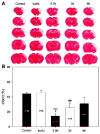Limb remote ischemic postconditioning protects against focal ischemia in rats
- PMID: 19631625
- PMCID: PMC2744502
- DOI: 10.1016/j.brainres.2009.07.029
Limb remote ischemic postconditioning protects against focal ischemia in rats
Abstract
Remote ischemic postconditioning (RIP) refers to an ischemia conducted in a distant organ that protects against a prior ischemia in another organ. We tested whether RIP protects against focal ischemia in the rat brain. Stroke was generated by a permanent occlusion of the left distal middle cerebral artery combined with a 30-min occlusion of the bilateral common carotid arteries (CCA) in male rats. After CCA release, RIP was generated by three cycles of 15-min occlusion/15-min release of the left-hind femoral artery. The results showed that rapid RIP performed immediately after CCA release reduced infarction by 67% measured at 2 days after stroke. In addition, delayed RIP initiated as late as 3 h, but not 6 h, still robustly reduced infarction by 43% 2 days after stroke. RIP's protective effect was abolished by injecting the protein synthesis inhibitor, cycloheximide, and the afferent nerve blocker, capsaicin, suggesting that RIP blocks ischemic injury by modulating protein synthesis and nerve activity. Nevertheless, rapid RIP did not reduce infarction size 2 months after stroke while it ameliorated the outcome of the behavioral test. In conclusion, RIP attenuates brain injury after focal ischemia.
Figures




Similar articles
-
Delayed postconditioning protects against focal ischemic brain injury in rats.PLoS One. 2008;3(12):e3851. doi: 10.1371/journal.pone.0003851. Epub 2008 Dec 10. PLoS One. 2008. PMID: 19066627 Free PMC article.
-
Limb remote-preconditioning protects against focal ischemia in rats and contradicts the dogma of therapeutic time windows for preconditioning.Neuroscience. 2008 Feb 19;151(4):1099-103. doi: 10.1016/j.neuroscience.2007.11.056. Epub 2007 Dec 15. Neuroscience. 2008. PMID: 18201834 Free PMC article.
-
Protective effects of ischemic postconditioning compared with gradual reperfusion or preconditioning.J Neurosci Res. 2008 Aug 15;86(11):2505-11. doi: 10.1002/jnr.21703. J Neurosci Res. 2008. PMID: 18438944
-
Interrupting reperfusion as a stroke therapy: ischemic postconditioning reduces infarct size after focal ischemia in rats.J Cereb Blood Flow Metab. 2006 Sep;26(9):1114-21. doi: 10.1038/sj.jcbfm.9600348. Epub 2006 May 31. J Cereb Blood Flow Metab. 2006. PMID: 16736038
-
Remote ischemic post-conditioning improves neurological function by AQP4 down-regulation in astrocytes.Behav Brain Res. 2015 Aug 1;289:1-8. doi: 10.1016/j.bbr.2015.04.024. Epub 2015 Apr 21. Behav Brain Res. 2015. PMID: 25907740 Review.
Cited by
-
Limb remote ischemic postconditioning protects integrity of the blood-brain barrier after stroke.Neural Regen Res. 2018 Sep;13(9):1585-1593. doi: 10.4103/1673-5374.237122. Neural Regen Res. 2018. PMID: 30127119 Free PMC article.
-
Effect of Repeated Remote Ischemic Preconditioning on Peripheral Arterial Disease in Patients Suffering from Intermittent Claudication.Cardiovasc Ther. 2019 Dec 10;2019:9592378. doi: 10.1155/2019/9592378. eCollection 2019. Cardiovasc Ther. 2019. PMID: 31897086 Free PMC article. Clinical Trial.
-
Neural mechanisms in remote ischaemic conditioning in the heart and brain: mechanistic and translational aspects.Basic Res Cardiol. 2018 Jun 1;113(4):25. doi: 10.1007/s00395-018-0684-z. Basic Res Cardiol. 2018. PMID: 29858664 Free PMC article. Review.
-
Biological networks in ischemic tolerance - rethinking the approach to clinical conditioning.Transl Stroke Res. 2013 Feb;4(1):114-29. doi: 10.1007/s12975-012-0244-z. Transl Stroke Res. 2013. PMID: 24223074 Free PMC article. Review.
-
Remote ischaemic conditioning and remodelling following myocardial infarction: current evidence and future perspectives.Heart Fail Rev. 2016 Sep;21(5):635-43. doi: 10.1007/s10741-016-9560-9. Heart Fail Rev. 2016. PMID: 27177446 Free PMC article. Review.
References
-
- Barone FC, White RF, Spera PA, Ellison J, Currie RW, Wang X, Feuerstein GZ. Ischemic preconditioning and brain tolerance: temporal histological and functional outcomes, protein synthesis requirement, and interleukin-1 receptor antagonist and early gene expression. Stroke. 1998;29:1937–1950. discussion 1950-1931. - PubMed
-
- Brzozowski T, Konturek PC, Konturek SJ, Pajdo R, Kwiecien S, Pawlik M, Drozdowicz D, Sliwowski Z, Pawlik WW. Ischemic preconditioning of remote organs attenuates gastric ischemia-reperfusion injury through involvement of prostaglandins and sensory nerves. Eur J Pharmacol. 2004;499:201–213. - PubMed
-
- Brzozowski T, Konturek PC, Pajdo R, Kwiecien S, Sliwowski Z, Drozdowicz D, Ptak-Belowska A, Pawlik M, Konturek SJ, Pawlik WW, Hahn GG. Importance of brain-gut axis in the gastroprotection induced by gastric and remote preconditioning. J Physiol Pharmacol. 2004;55:165–177. - PubMed
-
- Dietrich WD, Busto R, Alonso O, Globus MY, Ginsberg MD. Intraischemic but not postischemic brain hypothermia protects chronically following global forebrain ischemia in rats. J Cereb Blood Flow Metab. 1993;13:541–549. - PubMed
Publication types
MeSH terms
Substances
Grants and funding
LinkOut - more resources
Full Text Sources
Other Literature Sources
Miscellaneous

